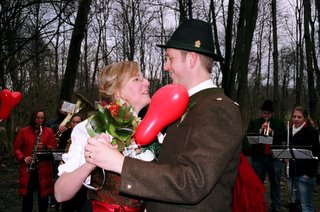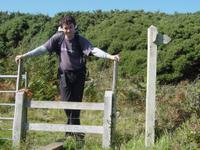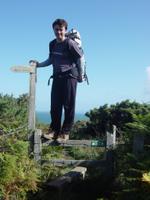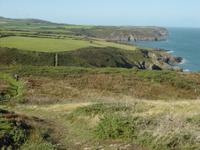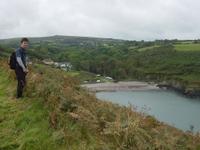A land of wild and wonderful beaches
 During the first two weeks of March Tom and I took a well earned holiday to Tasmania. On this trip we were never far from the sea...starting with our mode of transport to get there. On a Friday night we, alongwith our trusty ute, boarded the Spirit of Tasmania II at Station Pier in Port Melbourne with some trepidation, knowing that Bass straight was probably the second most fierce stretch of water in the world (after North/South Island crossing of our nearest neightbour, New Zealand). We needn't have worried... the engine vibration was more prominent than the ocean swell on the balmy autumn night and was quietly soothing whist we drifted off to sleep in our cabin...only to be awoken fiercly at 6am to the sound of piped music and the wakeup call that we would arrive at Devonport in 45 minutes!
During the first two weeks of March Tom and I took a well earned holiday to Tasmania. On this trip we were never far from the sea...starting with our mode of transport to get there. On a Friday night we, alongwith our trusty ute, boarded the Spirit of Tasmania II at Station Pier in Port Melbourne with some trepidation, knowing that Bass straight was probably the second most fierce stretch of water in the world (after North/South Island crossing of our nearest neightbour, New Zealand). We needn't have worried... the engine vibration was more prominent than the ocean swell on the balmy autumn night and was quietly soothing whist we drifted off to sleep in our cabin...only to be awoken fiercly at 6am to the sound of piped music and the wakeup call that we would arrive at Devonport in 45 minutes! From Devonport we drove straight on (after a couple of hot cross buns and a cup of tea from the bakery) to our planned first night's accommodation... the sand dunes of Mt William NP on the north-east tip of Tassie. We had packed all of the camping gear in the back of the ute (well we hoped so) and prepared with our National Parks Pass (conveniently available for sale on the Ferry - $20 per day!!! or $50 for 2 months) we set up camp at Stumpy's Bay #4. It was a pretty site with a lagoon and a number of persistent wallabies (and also a Tiger snake as we later found). Our main pastime at this campsite was the long beach walks on the fine white sand. The beach was stunning with it's orange lichen crusted rocks, white sand and hardly a soul on it. There must have only been about 15 people in all of the 4 camping grounds combined. Most were in campervans, but we stuck with our trusty budget dome tent. We also climbed the 218m peak of Mount William - despite not being amonst the highest peaks even of Tasmania, still had fine views for a full 360 degrees.
From Devonport we drove straight on (after a couple of hot cross buns and a cup of tea from the bakery) to our planned first night's accommodation... the sand dunes of Mt William NP on the north-east tip of Tassie. We had packed all of the camping gear in the back of the ute (well we hoped so) and prepared with our National Parks Pass (conveniently available for sale on the Ferry - $20 per day!!! or $50 for 2 months) we set up camp at Stumpy's Bay #4. It was a pretty site with a lagoon and a number of persistent wallabies (and also a Tiger snake as we later found). Our main pastime at this campsite was the long beach walks on the fine white sand. The beach was stunning with it's orange lichen crusted rocks, white sand and hardly a soul on it. There must have only been about 15 people in all of the 4 camping grounds combined. Most were in campervans, but we stuck with our trusty budget dome tent. We also climbed the 218m peak of Mount William - despite not being amonst the highest peaks even of Tasmania, still had fine views for a full 360 degrees. After a few days at Mount William we moved on to the next stunning white sand beach... that of Bay of Fires, north of St Helens. Allegedly this is the second best wild beach in the world (I forget what is the best... probably Whitehaven in the Whitsunday islands of Queensland). Bay of Fires is actually less "wild" than Mount William due to the number of people staying there, and to be honest this was probably it's only detractor. It was a fine beach, though I did prefer Mt William due to it's isolation... and probably because it was the first we went to and had the best weather.
After a few days at Mount William we moved on to the next stunning white sand beach... that of Bay of Fires, north of St Helens. Allegedly this is the second best wild beach in the world (I forget what is the best... probably Whitehaven in the Whitsunday islands of Queensland). Bay of Fires is actually less "wild" than Mount William due to the number of people staying there, and to be honest this was probably it's only detractor. It was a fine beach, though I did prefer Mt William due to it's isolation... and probably because it was the first we went to and had the best weather.  Cockle Creek was beautiful. The weather was more than good. There was clear blue sky, no wind, and Recherche Bay had clear still water. Only downside was the wasps and bumble bees. We walked along the bay learning about the early whaling history of the area and drinking in the sheer beauty. We also kept up our exercise regime by taking the 4hour return walk to South Cape beach. Along the way we met many surfers carrying their boards across. Many of them were camping out there. We were tempted to continue a bit more of the south cape path, but after 20 minutes of bush bashing, called it quits and headed back to Cockle Creek. I think the rest of the South West Cape trail may not be so well maintained as this first bit! It was a warm day, so once back at Cockle Creek I though a swim to freshen up might be in order. If freshening up was the only objective, then it was met with no questions, however the swim was not exactly relaxing... the water was freeeeeeezing, despite the 25 degrees air temperature, and I barely laster 10 seconds under water.
Cockle Creek was beautiful. The weather was more than good. There was clear blue sky, no wind, and Recherche Bay had clear still water. Only downside was the wasps and bumble bees. We walked along the bay learning about the early whaling history of the area and drinking in the sheer beauty. We also kept up our exercise regime by taking the 4hour return walk to South Cape beach. Along the way we met many surfers carrying their boards across. Many of them were camping out there. We were tempted to continue a bit more of the south cape path, but after 20 minutes of bush bashing, called it quits and headed back to Cockle Creek. I think the rest of the South West Cape trail may not be so well maintained as this first bit! It was a warm day, so once back at Cockle Creek I though a swim to freshen up might be in order. If freshening up was the only objective, then it was met with no questions, however the swim was not exactly relaxing... the water was freeeeeeezing, despite the 25 degrees air temperature, and I barely laster 10 seconds under water. of the charter voyages down the east cost of Bruny Island. Aim was to get to a small island seal colony to the south of Bruny Island, but unfortunately the weather was against us. with 30-40 knot winds and 3-4m swell, conditions were not safe for us to go beyond the meeting of the Tasman Sea and Southern Ocean. We did see plenty on the way though with a few albatross and Shearwaters galore. We also sped through "the monument" which was slightly hair raising (see photos)! The evening treat was dinner at Peppermint Bay, overlooking a splendid sunset over Bruny Island. Food was pretty good too!
of the charter voyages down the east cost of Bruny Island. Aim was to get to a small island seal colony to the south of Bruny Island, but unfortunately the weather was against us. with 30-40 knot winds and 3-4m swell, conditions were not safe for us to go beyond the meeting of the Tasman Sea and Southern Ocean. We did see plenty on the way though with a few albatross and Shearwaters galore. We also sped through "the monument" which was slightly hair raising (see photos)! The evening treat was dinner at Peppermint Bay, overlooking a splendid sunset over Bruny Island. Food was pretty good too!From Hobart we travelled straight up through the centre of Tasmania, past the great lakes (Tassie is in drought too... there is a lot of water missing from these lakes) up to Devonport. A nice lunch at the Deloraine Deli, and sampling some local gourmet delights at the Honey Farm, Ashgrove Cheeses and D'Anver's Chocolates filled in the time before our ferry back to Melbourne.
Click here to see our full photo album.





